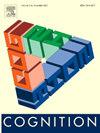A body detection inversion effect revealed by a large-scale inattentional blindness experiment
IF 2.8
1区 心理学
Q1 PSYCHOLOGY, EXPERIMENTAL
引用次数: 0
Abstract
As a social species, humans preferentially attend to the faces and bodies of other people. Previous research revealed specialized cognitive mechanisms for processing human faces and bodies. For example, upright person silhouettes are more readily found than inverted silhouettes in visual search tasks. It is unclear, however, whether these findings reflect a top-down attentional bias to social stimuli or bottom-up sensitivity to visual cues signaling the presence of other people. Here, we tested whether the upright human form is preferentially detected in the absence of attention. To rule out influences of top-down attention and expectation, we conducted a large-scale single-trial inattentional blindness experiment on a diverse sample of naive participants (N = 13.539). While participants were engaged in judging the length of a cross at fixation, we briefly presented an unexpected silhouette of a person or a plant next to the cross. Subsequently, we asked whether participants noticed anything other than the cross. Results showed that silhouettes of people were more often noticed than silhouettes of plants. Crucially, upright person silhouettes were also more often detected than inverted person silhouettes, despite these stimuli being identical in their low-level visual features. These results were replicated in a second experiment involving headless person silhouettes. Finally, capitalizing on the exceptionally large and diverse sample, further analyses revealed strong detection differences across age and gender. These results indicate that the visual system is tuned to the form of the upright human body, allowing for the quick detection of other people even in the absence of attention.
大规模不注意盲视实验揭示的身体检测反转效应
作为一种社会物种,人类优先关注他人的脸和身体。先前的研究揭示了处理人脸和身体的特殊认知机制。例如,在视觉搜索任务中,直立的人物剪影比倒置的人物剪影更容易被发现。然而,尚不清楚这些发现是否反映了自上而下的对社会刺激的注意偏见,还是自下而上的对他人存在的视觉线索的敏感。在这里,我们测试了直立的人类形态是否在缺乏注意力的情况下被优先检测到。为了排除自上而下的注意和期望的影响,我们对不同样本的幼稚参与者(N = 13.539)进行了大规模的单试验无意盲实验。当参与者在注视时判断十字架的长度时,我们简要地展示了十字架旁边一个意想不到的人或植物的剪影。随后,我们询问参与者是否注意到除了十字架之外的其他东西。结果表明,人的剪影比植物的剪影更容易被注意到。至关重要的是,直立的人剪影也比倒立的人剪影更容易被发现,尽管这些刺激在低级视觉特征上是相同的。这些结果在第二个无头人剪影实验中得到了重复。最后,利用异常庞大和多样化的样本,进一步的分析揭示了年龄和性别之间的强烈检测差异。这些结果表明,视觉系统被调整为直立的人体形式,即使在没有注意的情况下也能快速发现其他人。
本文章由计算机程序翻译,如有差异,请以英文原文为准。
求助全文
约1分钟内获得全文
求助全文
来源期刊

Cognition
PSYCHOLOGY, EXPERIMENTAL-
CiteScore
6.40
自引率
5.90%
发文量
283
期刊介绍:
Cognition is an international journal that publishes theoretical and experimental papers on the study of the mind. It covers a wide variety of subjects concerning all the different aspects of cognition, ranging from biological and experimental studies to formal analysis. Contributions from the fields of psychology, neuroscience, linguistics, computer science, mathematics, ethology and philosophy are welcome in this journal provided that they have some bearing on the functioning of the mind. In addition, the journal serves as a forum for discussion of social and political aspects of cognitive science.
 求助内容:
求助内容: 应助结果提醒方式:
应助结果提醒方式:


